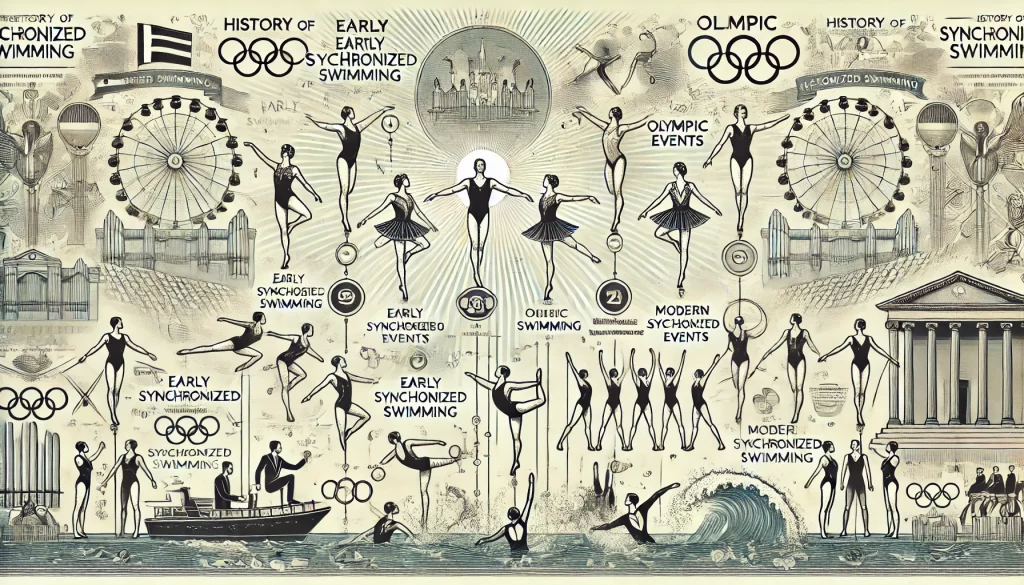
Synchronized swimming, known for its blend of artistry and athleticism, has evolved into a popular and respected sport over the years. From its early beginnings to its recognition on the world stage, the history of synchronized swimming is as graceful and intricate as the performances themselves. This article explores the development of synchronized swimming, highlighting key milestones and influential figures who have shaped the sport.
Early Beginnings
The Roots of Water Ballet
The origins of synchronized swimming can be traced back to the late 19th and early 20th centuries when it was commonly referred to as “water ballet.” During this time, water spectacles were a popular form of entertainment, particularly in Europe and North America. These performances often featured women performing coordinated and artistic movements in the water, accompanied by music.
Annette Kellerman: The Pioneer
One of the earliest pioneers of water ballet was Annette Kellerman, an Australian swimmer, and actress. In the early 1900s, Kellerman’s water performances captivated audiences in the United States and Europe. She is often credited with popularizing the concept of synchronized swimming and promoting it as a legitimate sport and form of entertainment.
The Evolution of Synchronized Swimming
The Rise of Competitions
Synchronized swimming began to take on a more structured form in the 1920s and 1930s. The first recorded synchronized swimming competition took place in 1924 in Montreal, Canada. During this period, clubs and organizations dedicated to the sport started to emerge, and the first official rules and judging criteria were established.
Esther Williams: Hollywood’s Influence
The 1940s and 1950s saw a surge in the popularity of synchronized swimming, thanks in large part to Hollywood. Esther Williams, a competitive swimmer turned actress, starred in a series of popular aquatic-themed movies that showcased synchronized swimming routines. Her films, such as “Bathing Beauty” (1944) and “Million Dollar Mermaid” (1952), brought widespread attention to the sport and inspired many to take up synchronized swimming.
Synchronized Swimming on the World Stage
Recognition as a Competitive Sport
Synchronized swimming gained official recognition as a competitive sport in the 1950s and 1960s. The International Swimming Federation (FINA) included synchronized swimming in its events, and the sport was featured in the Pan American Games in 1955. The creation of standardized rules and the introduction of international competitions helped to formalize synchronized swimming as a legitimate athletic discipline.
Olympic Inclusion
A major milestone in the history of synchronized swimming was its inclusion in the Olympic Games. Synchronized swimming made its Olympic debut as a demonstration sport at the 1952 Helsinki Games. However, it wasn’t until the 1984 Los Angeles Olympics that synchronized swimming became an official Olympic sport. The inaugural Olympic events included solo and duet routines, and later, team events were added to the program.
Modern Developments
Expanding the Sport
In recent years, synchronized swimming has continued to evolve and expand. The sport has seen the introduction of mixed-gender events, allowing male athletes to compete alongside female athletes. This development has broadened the appeal of synchronized swimming and showcased the versatility and inclusivity of the sport.
Technological Advancements
Advancements in technology have also played a role in the development of synchronized swimming. Underwater speakers, video analysis, and sophisticated training techniques have enhanced the precision and artistry of performances. These innovations have allowed athletes to push the boundaries of what is possible in the water.
Notable Figures in Synchronized Swimming
Coaches and Choreographers
Several individuals have made significant contributions to the sport of synchronized swimming. Coaches and choreographers like Sarah Josephson and Candy Costie, who won the first Olympic gold medals in synchronized swimming, have been instrumental in developing new techniques and pushing the sport forward.
Athletes
Athletes such as Svetlana Romashina and Natalia Ishchenko of Russia have dominated the sport in recent years, winning multiple Olympic and World Championship titles. Their achievements have inspired a new generation of synchronized swimmers and elevated the sport’s profile on the global stage.
Conclusion
The history of synchronized swimming is a testament to the sport’s enduring appeal and the dedication of its athletes and pioneers. From its origins in water ballet to its recognition as an Olympic sport, synchronized swimming has captivated audiences with its blend of grace, precision, and athleticism. As the sport continues to evolve, it remains a unique and cherished part of the world of competitive swimming.